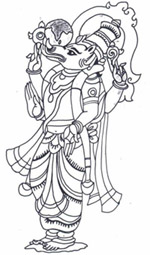The Ten Avataras 3
A Psychological Study of the Evolution of Humankind
Swami Satyadharma Saraswati
3. VARAHA AVATARA
 The
advent of Varaha, the third incarnation of Lord Vishnu, relates to ancient
creation myths from pre-Vedic and Vedic times when divinity was seen to
be inherent in the forces of nature. Here, Vishnu, the Lord of the Universe,
descends in the form of the boar, an animal which roots and grubs in the
earth. The boar is known for its strength and bravery as well as fecundity
and was used in many ancient rites relating to fertility of the earth.
By rooting up the earth, the boar taught ploughing to the people. The
boar is also closely related to water, moisture and is a sign of immediate
rain. The boar represents the transition of consciousness from the subconscious
to the conscious dimension. At this level of evolution the conscious dimension
is just beginning to operate through tamas and is totally veiled or limited
to the lower animal instincts.
The
advent of Varaha, the third incarnation of Lord Vishnu, relates to ancient
creation myths from pre-Vedic and Vedic times when divinity was seen to
be inherent in the forces of nature. Here, Vishnu, the Lord of the Universe,
descends in the form of the boar, an animal which roots and grubs in the
earth. The boar is known for its strength and bravery as well as fecundity
and was used in many ancient rites relating to fertility of the earth.
By rooting up the earth, the boar taught ploughing to the people. The
boar is also closely related to water, moisture and is a sign of immediate
rain. The boar represents the transition of consciousness from the subconscious
to the conscious dimension. At this level of evolution the conscious dimension
is just beginning to operate through tamas and is totally veiled or limited
to the lower animal instincts.
The myths of Varaha are very widespread and span the entire Indian literature. Varaha represents the tamasic stage of creation in which the Earth is solidified from the watery mass. From the primal waters, Earth arose to form a foundation for the other elements and forms of creation. In the Vedas a myth is narrated about the birth of Prithvi, Earth, which states that Prajapati, the lord of created beings, looking all around, beheld only the waters. Desiring further creation, he performed tapas, austerity. Becoming weary, he finally saw a lotus leaf floating on the water. He thought there must be something firm in which the lotus was rooted. So he took the form of a boar and dived deep down until he reached the Earth below. He rammed the Earth with his tusks and emerged from the water still holding it. He spread the Earth out on the lotus leaf and thus it expanded, becoming Prithvi, the abode of all beings.
Later, in Ramayana and many of the original Puranic texts, the role of Prajapati is taken over by Brahma who assumes the form of Varaha in order to raise the Earth. In later versions of the Puranas, Brahma gives way to Narayana. Still later, with the growing popularity of Vaishnavism, modifications were made in the old texts to give the place to Vishnu. With the transition of identity from Prajapati/Brahma to Narayana/Vishnu, the old creation myths are transformed into the classical doctrine of avatara to meet the basic theme of upholding dharma, righteousness, and destroying adharma, unrighteousness, within society.
We see this trend starting in the Mahabharata which narrates that once the population of Earth became so great that it sank down under the weight. So Vishnu assumed the form of the boar and lifted her up from the nether regions into which she had sunk and restored her to her place. In a later myth, it is told that before the pralaya, the dissolution of creation at the end of an aeon, an asura or demon by the name of Hiranyaksha received a boon from Brahma of invulnerability from assaults by gods, men and various animals, which were enumerated, but the boar was forgotten. Later the asura, growing arrogant, rolled Prithvi into a mat and stole her away to Patala, the lowest level of evolution, which initiated the pralaya. Vishnu then assumed the form of Varaha and dived down to the subterranean levels. After reaching Patala, he vanquished Hiranyaksha, recovered Earth and restored her to her place.
In the Srimad Bhagavata Purana, the grunting roars of the Divine, appearing in the form of Varaha, the causal boar, are beautifully described. Here Varaha is eulogized as the embodiment of yajna, or sacrifice, as he raises the Earth up from the infinite expanse of water on his enormous white tusks, against the background of his huge blue-black body. Varaha is saluted as the form of yajna because consciousness, along with its evolutes of ego, mind and senses, are established on Earth at this point in evolution. With the development of consciousness and all the innumerable types of sentient and insentient beings on Earth, the need for sacrifice, or offering back to the source of creation, arose as man began to understand his connection with material things as well as with the forces of nature and the divine.
So, all the yajnas, or sacrificial ceremonies, were said to be latent in the pores of Varaha, the causal boar. The sacrificial grass was his hair, the ghee pot his eyes, the soma his semen, and the yajna priests his legs. All the yajnas, lasting from one day to one thousand years, were his joints and the different kinds of yajna were his dhatus, or bodily elements. Being the embodiment of yajna, Varaha also manifests as all the mantras, deities and material offerings utilized in the yajna. Thus all the rites of yajna are identical with Varaha, the descent of cosmic consciousness to the earthly dimension in the form of the causal boar.
Continued in the next issue